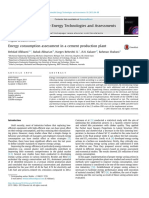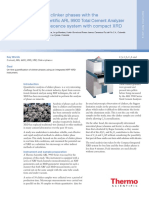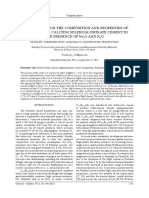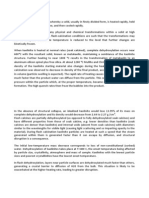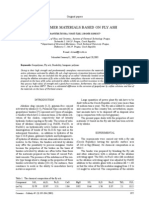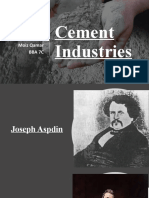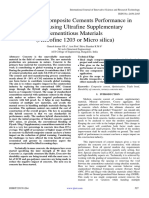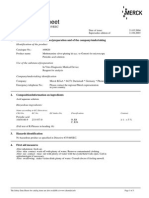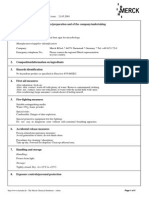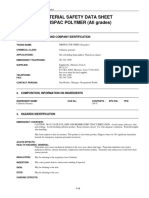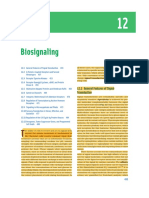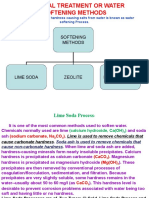Kiln Control Using Continuous On-Stream XRD: A Proven Technology
Kiln Control Using Continuous On-Stream XRD: A Proven Technology
Uploaded by
Siti HannaCopyright:
Available Formats
Kiln Control Using Continuous On-Stream XRD: A Proven Technology
Kiln Control Using Continuous On-Stream XRD: A Proven Technology
Uploaded by
Siti HannaOriginal Title
Copyright
Available Formats
Share this document
Did you find this document useful?
Is this content inappropriate?
Copyright:
Available Formats
Kiln Control Using Continuous On-Stream XRD: A Proven Technology
Kiln Control Using Continuous On-Stream XRD: A Proven Technology
Uploaded by
Siti HannaCopyright:
Available Formats
- 1 - www.fctinternational.
com
Kiln control using Continuous On-Stream XRD
By: Dr Peter Storer, Technical Manager, FCT-ACTech Pty Ltd and
Mr Con Manias, Managing Director, FCT-ACTech Pty Ltd
A Proven Technology
FCT-ACTechs Continuous On-Stream XRD Analyser (Figure 1) has proven to be a
reliable technology for analyzing the complete mineral content of a moving powder
stream in real time. It has proven performance in cement quality control applications,
operating successfully at cement mill installations in Australia and the USA
1,2,3
. In this
paper we discuss the benefits of using Continuous On-Stream XRD for monitoring
clinker mineralogy in real time as it is being produced.
Figure 1 FCT-ACTech continuous on-stream XRD analyser.
Clinker Production
The kiln pyro-processing is the heart of the cement manufacturing process, where the
greater part of the operating costs are incurred, and where subsequent cement quality is
largely determined. This part of the cement manufacturing process attracts more
attention that any other for many reasons, including:
The high cost of fuel, and the substantial savings possible from even a small reduction
in specific fuel consumption
1
Manias C, Retallack D and Madsen I, XRD for On-line Analysis and Control, World Cement, Feb 2000
2
Godek A, Crutchfield D, Blackham F, Storer P, Manias C and Madsen I, Proactive Not Reactive, World
Cement, Feb 2002
3
Manias C, Retallack D and Storer P, In Control, World Cement, Oct 2002
- 2 - www.fctinternational.com
The potential for improving clinker quality with improved heat flux profile, with
subsequent savings in grinding energy, and marketing advantages
The need to reduce gaseous emissions to meet compliance levels
Potential for other operating cost reductions (refractory use, kiln stability etc)
Mineralogical Composition
0
10
20
30
40
50
60
1/07/02 0:00 1/07/02 8:00 1/07/02 16:00 2/07/02 0:00
Time
P
e
r
c
e
n
t
0
5
10
15
20
25
Alite
Belite-b
Belite-g
Ferrite
Aluminate-o
Aluminate-c
Fig 2 Continuous XRD Trend of clinker minerals in real time
Because of the large potential savings, cement plant operators have invested heavily in
improving kiln control, and over the decades very sophisticated expert systems have
evolved to this end. However, these control the equipment (fans, fuel, feed rates, etc)
without knowing what is happening to the material being processed in the kiln, except
through circumstantial evidence.
The continuous on-stream XRD is an invaluable tool for providing the missing
information continuously and in real time, on which kiln control can be based. This
provides the basis for a new level of kiln control, where the controlled parameter is the
clinker mineralogy, including percentages of alite, belite, ferrite, aluminate, free lime,
alkali sulfate, periclase or any other species of interest. Furthermore, by monitoring the
various forms of the clinker minerals (,,, ortho-rhombic, cubic etc) the kiln operation
could be adjusted (calciner operation, kiln speed, burner set up, cooler operation for
example) to ensure production at the optimum quality and cost position.
The On-Stream XRD Analysis Process
In cement product applications, the cement can be fed directly to the Continuous On-
Stream XRD without further treatment. For clinker analysis, the clinker must be ground
to approximately 50% passing 45 micron. This requires a continuous sample taken at the
cooler discharge, modified cooler grate or at the kiln nose ring, and further prepared for
presentation to the XRD. (It should be noted however that taking a representative
- 3 - www.fctinternational.com
sample at the kiln discharge or even along a cooler somewhere could be extremely
problematical because of the segregation that occurs there). A sample can also be taken
from a clinker transfer point, as shown in Figure 3.
A virtually continuous bulk sample is crushed and then sub-sampled to provide a smaller,
continuous, representative sample of about 300 - 600grams/minute which is milled to
provide a sample that is fed continuously through the XRD. The excess crushed clinker
sample and the ground, analyzed sample is continuously returned to the clinker transport
system.
The Continuous On-Stream XRD analyses a moving bed of ground clinker, using its
unique area detector to continuously collect the complete XRD pattern. In this way, the
analyser is able to produce real time trends of all clinker minerals including free lime
contained in the clinker. This trend displayed in the control room and laboratory is the
basis for control actions. No other XRD analyser on the market today produces a
complete mineralogical composition of a moving bed of material in real time. In addition
the moving bed of material provides the best opportunity to ensure that the analysis
returned is truly representative of the bulk stream. An automated laboratory based batch
analyser would take many days to analyze the amount of sample that moves through a
Continuous On-Stream XRD in one hour.
Clinker Mineralogy, Free Lime, NOx and Fuel Consumption
Clinker mineralogy is a function of the elements present in the kiln feed AND the
treatment they receive in the kiln. Bogue equations, historically used to calculate a
hypothetical mineral composition ignore the heat treatment in the kiln, and assume an
idealized equilibrium reaction. Consequently, as is now commonly known by cement
chemists, the Bogue equations rarely agree with the real composition of clinker and
cement, and can be very misleading.
A continuous on-stream XRD analyzing clinker will report exactly what is being
produced, and allow kiln adjustment to optimize the clinker composition. For example,
one plant site was found to have relatively high proportions of -C
2
S in the clinker,
pointing to a long slow cooling rate that could be addressed by cooler operation and
burner set up. Other plants experience large swings in clinker mineralogy as a result of
using alternative fuels, while others have large fluctuations in clinker reactivity and
cement behaviour without any warning or indication. None of these above are indicated
by the conventional XRF analysis that most plants still rely on.
Free lime has been used as an indication of clinker burning. The presence of free lime in
clinker may be due to a number of reasons. These include
4
:
inhomogeneous raw meal
raw meal too coarse
raw meal LSF too high
inadequate burning (such that the free lime is not combined with the other oxides)
4
D Knfel, in Labahn and Kohlhaas, Cement Engineers Handbook, Bauverlag, 1983
- 4 - www.fctinternational.com
Figure 3 Schematic for clinker sampling at a transfer point (1). A sampler cuts a
portion of the main clinker stream at the transfer point (2), and this is processed by
the crusher (3), reduced to a smaller sample by the rotary divider (4) and milled to a
powder (5). The powdered clinker is sent though the continuous XRD via a
feedscrew (6). Excess sample and analysed sample is returned to the process (7).
1
2
3
4
XRD
5
6
7
7
- 5 - www.fctinternational.com
By having a complete picture of variations in the free lime it should be possible to
correlate variations in the free lime with the correct cause, and thereby take appropriate
corrective action.
The laboratory test typically takes some hours to produce a result by conventional wet
methods, and almost as long with laboratory based XRD. The continuous on-stream
XRD produces a result in real time giving the kiln operator relevant and timely
information for kiln control. This free lime analysis together with other compositional
information can also be automatically read by an expert system controlling the kiln. It
should be noted here though that free lime on its own can be a dangerous measure if not
taken in context with the complete composition. There have been many cases of severe
damage done to kilns as a result of a kiln operator trying to achieve a free lime target that
was impossible to reach because of chemical composition.
Controlling free lime to a target though is normal for cement production. However, more
often than not, clinker free limes are much lower than the nominal target. The reasons
are that a hard burned kiln is more stable as it can cope with process variations better. It
may be that the chemical variation is high or feed rate or fuel rate variable and the kiln is
burned hard to prevent regular upsets. A continuous on-stream XRD would indicate all
of this and provide precise information for kiln control.
NOx Levels as a function of kiln burning
Hard burning is a very expensive way to operate, with the costs largely hidden. These
costs are in fuel consumption, production rate, clinker quality and NOx emissions. NOx
levels are primarily dependent on how hard a kiln is being burned, and figure 4 above is
from a recent investigation of a calciner kiln. Clearly, better kiln control can reduce NOx
emissions by 30 40%, and with the aid of a continuous on-stream XRD to achieve this,
such technology should be of interest to those plants striving to minimize NOx emissions.
Fuel Consumption as a function of kiln burning
It is well known that hard burning uses more fuel per kg of clinker. As a general rule,
increasing free lime in clinker from about 0.3% to an average of 1% will reduce specific
fuel consumption by around 5%, and will result in a 5% increase in production rate from
that kiln. This equates to a considerable economic advantage through better kiln control
possible now through the availability of continuous on-stream XRD.
Clinker Quality as a function of kiln burning
Clinker quality, or reactivity, is also largely affected by the kiln heat treatment. While
high free lime means that less alite and belite are formed, as well as introducing possible
soundness issues with concrete, low free lime is also detrimental. The hard burning of
clinker does form some of the less reactive phases leading to slow strength development.
- 6 - www.fctinternational.com
400
500
600
700
800
900
1000
0 0.2 0.4 0.6 0.8 1 1.2 1.4 1.6
Freelime, %
N
O
x
(
l
b
/
h
r
)
NOx
Figure 4 Correlation between free lime and NOx emissions.
So generally, as depicted in figure 5 below, there will be an optimum free lime for
optimal strength development in cement. Typically this lies in the 1.0% to 1.5% range.
Hard burning can reduce 28 day cement strengths by 5 10 MPa, compared to the
optimum potential strength of the cement.
Figure 5 also indicates the clinker grindability as a function of free lime, and as expected
harder burning leads to harder to grind clinker. Cement mill throughput can be affected
by up to 10% depending on how hard the clinker is burned.
The implications for this can be severe for a cement mill, especially where cement mill
capacity is limiting. Compare clinker at 1% free lime with clinker at 0.3% free lime as an
example. Firstly, a 10% drop in strength at 28 days will mean that finer grinding will be
required in an effort to regain some of that strength, while at the same time, the clinker
will be 6% harder to grind. The combined effect will be at least a 15% loss of cement
mill throughput.
Complete Analysis
In many plants a laboratory XRD is being used for free lime only. This is partly a legacy
of older XRD technology and analysis software. In older XRD analysers collecting a
iffraction pattern could be time consuming because the hardware required each angle to
be collected sequentially, by scanning the detector over the angular range of interest. For
this reason it became simpler to limit the data collection to the range of angles that were
relevant to free lime measurement. In addition the data analysis is likely to be based
simply on the count rate of one of the free lime peaks, which requires careful
standardization to maintain accuracy.
- 7 - www.fctinternational.com
Figure 5 Cement Strengths as a function of clinker free lime.
The FCT-ACTech Continuous On-Stream XRD analyser uses a patented full area
detector, which is able to measure the entire diffraction pattern simultaneously without
moving. This full area detector, combined with the latest fundamental parameter
Rietveld pattern analysis, is ideal for continuous measurement and provides a complete
picture of the cement mineralogy. Continuous On-Stream XRD analysis has the
advantage of providing a much more complete picture of what is actually happening.
Comparing laboratory XRD with continuous XRD is like comparing single photos to a
complete video of the mineralogy emerging from the kiln.
In the FCT-ACTech XRD analyser, the diffraction pattern analysis is performed using a
fundamental parameter Rietveld analysis, which gives a complete quantitative and
standardless analysis of the pattern. The accuracy of this method has been tested and
proven
2,5
. Rietveld analysis gives a complete breakdown of all of the minerals present in
the clinker stream. This is highly relevant to proper quality control. For example it is
possible to monitor the concentration of the gamma form of belite, which is an
undesirable consequence of operating the kiln with slow heating, and or inadequate
quenching of the hot clinker as it exits the kiln.
5
Scarlett N, Madsen I, Manias C and Retallack D, Powder Diffraction, June 2001.
45
0.5
50
55
2.0 1.5 1.0 3.0
110%
130%
150%
S
T
R
E
N
G
T
H
MPa
G
R
I
N
D
A
B
I
L
I
T
Y
W.r.t.
300
2
/kg
% Free Lime
Schematic Optimum Free Lime vs. 28 Day Strength and Grindability
Strength1-2.ppt
G
rin
d
a
b
ility
( a
c
tu
a
l)
C
e
m
e
n
t S
tre
n
g
th
(a
c
tu
a
l)
Optimum %Free Lime
In
c
re
a
s
in
g
C
3 S
(th
e
o
re
tic
a
l stre
n
g
th
)
O
v
e
r
b
u
r
n
I
n
g
- 8 - www.fctinternational.com
Mineral Shorthand, or composition
Alite C3S
Belite beta C2S-
Belite gamma C2S-
Aluminate cubic C3A-c
Aluminate orthorombic C3A-o
Ferrite alpha C4AF-
Ferrite beta C4AF-
Lime CaO
Periclase MgO
Arcanite K
2
SO
4
Quartz SiO
2
Table 1 Summary of some mineral phases measured (also trended with time)
FCT-ACTechs XRD Rietveld analysis includes the clinker minerals shown in Table 1.
From Table 1 it is clear that the analysis provided by a properly analysed XRD pattern is
indeed extensive, and other minerals can be included in the analysis if desired. It is
important to note that the values measured for the standard components (eg. C3S etc.) are
true measures of the cement mineralogy, and not the Bogue values that are calculated
from chemistry. As discussed earlier, there are usually large discrepancies between
Bogue calculated hypothetical composition and the true mineralogy as given by XRD.
XRD can also monitor any compound of interest in clinker such as the percentage of
Periclase (free MgO) in the clinker, which can be just as important for expansion as free
lime.
If the plant is producing more than one type of clinker then the Continuous On-Stream
XRD will give a clear indication of the type change, showing when to switch from one
storage point to another, since a change to a different type will be clearly distinguished in
a timely manner. This results in improved quality and an optimum usage of the higher
value clinker. This can be particularly useful with oil well clinker production, where
clinker quality and suitability for oil well cement can be difficult to establish.
Conclusion
Most modern plants now use sophisticated expert control systems to optimise their kiln
operation, but even the best control system cannot compensate for a lack of data. By
using a Continuous On-Stream XRD the control system has access to extremely valuable
information about the processes occurring in the kiln and clinker cooler. In particular the
XRD provides detailed information about the trends in mineralogy, and these trends can
be correlated with operating conditions. This information enables the control system and
operators to achieve the optimum operating conditions, with all of the associated benefits,
such as improved clinker quality, improved clinker grindability, reduced emissions and
reduced fuel consumption.
You might also like
- 13.energy Consumption Assessment in A Cement Production PlantDocument6 pages13.energy Consumption Assessment in A Cement Production PlantzeeNo ratings yet
- Blank 6Document11 pagesBlank 6Marwan AbuzayanNo ratings yet
- CementDocument15 pagesCementMohammedAbbas50% (2)
- Tuto Chapter 1Document2 pagesTuto Chapter 1nelmesery.anafNo ratings yet
- RBM Amenability - StudyDocument40 pagesRBM Amenability - StudyMgn SanNo ratings yet
- Analysis Clinker Phases ARL 9900Document4 pagesAnalysis Clinker Phases ARL 9900FranciscoCorreaJara100% (1)
- Characterization of Fly AshDocument79 pagesCharacterization of Fly Ashskyruler_k86No ratings yet
- XRD Machine For Clinker Quality AssessmentDocument4 pagesXRD Machine For Clinker Quality AssessmentApurba SarmaNo ratings yet
- Tosf15 5Document240 pagesTosf15 5Samantha PowellNo ratings yet
- Characterization of Cement Minerals, Cements and Their Reaction Products at The Atomic and Nano ScaleDocument21 pagesCharacterization of Cement Minerals, Cements and Their Reaction Products at The Atomic and Nano ScaleyinglvNo ratings yet
- The Importance of Sample Load in Commercial Through Belt PGNAA Applications Reduced SizeDocument14 pagesThe Importance of Sample Load in Commercial Through Belt PGNAA Applications Reduced SizeLaboratorio Automatización Industrial100% (1)
- Soil CharacterizationDocument41 pagesSoil CharacterizationMohd Aftab0% (1)
- Charecterization of Pozzolana and Its Effect On Cement PropertiesDocument54 pagesCharecterization of Pozzolana and Its Effect On Cement PropertiesMemo Yassin88% (8)
- Lecture 5 - Application of Leaching SystemsDocument25 pagesLecture 5 - Application of Leaching SystemsGRAHAM KUNDAI DENGEZANo ratings yet
- Cement Chemistry 2016 BL1Document41 pagesCement Chemistry 2016 BL1Tyo Deka100% (1)
- Effect of MgODocument10 pagesEffect of MgOM. Ali ParvezNo ratings yet
- Cement 1Document36 pagesCement 1Shakil AhamedNo ratings yet
- EasyCal-User Guide Rev3.0 Bruker XRFDocument89 pagesEasyCal-User Guide Rev3.0 Bruker XRFminhthienbk100% (1)
- REFERENCES in Cement Chem.Document8 pagesREFERENCES in Cement Chem.Henok Moges KassahunNo ratings yet
- 1.1 Program KymoreDocument2 pages1.1 Program Kymoresaji kumarNo ratings yet
- CementDocument55 pagesCementSajjad AhmadNo ratings yet
- Application of XRD, XRFDocument59 pagesApplication of XRD, XRFHONNEY TAAKNo ratings yet
- Portland Cement PDS v6Document2 pagesPortland Cement PDS v6Joseph ChenNo ratings yet
- Properties of FrothsDocument35 pagesProperties of Frothschandafelix217No ratings yet
- Density TestDocument41 pagesDensity TestAlbyNo ratings yet
- Cement Manufacturing: Industry Description and PracticesDocument4 pagesCement Manufacturing: Industry Description and PracticesSambhu YadavNo ratings yet
- Sample Preparation For X-Ray AnalysisDocument2 pagesSample Preparation For X-Ray Analysishas407No ratings yet
- PGNAADocument27 pagesPGNAAJa Phe Ti100% (1)
- Utilisation of Fly Ash in Cement ConcreteDocument6 pagesUtilisation of Fly Ash in Cement Concreteadnan-hNo ratings yet
- A New Autogenous and Semi-Autogenous Mill Model For Scale-Up, Design and OptimisationDocument9 pagesA New Autogenous and Semi-Autogenous Mill Model For Scale-Up, Design and OptimisationJuanOlivaresNo ratings yet
- Benchmarking Comminution Energy Consumption For The Processing - Ballantyne2014Document6 pagesBenchmarking Comminution Energy Consumption For The Processing - Ballantyne2014Gottumukkala Venkateswara RaoNo ratings yet
- Dynamic Calibration and Validation Testing: The World Leader in Serving ScienceDocument25 pagesDynamic Calibration and Validation Testing: The World Leader in Serving ScienceRajaram Jayaraman100% (1)
- Flash CalcinationDocument4 pagesFlash CalcinationalulatekNo ratings yet
- Tyoes of Cement and ApplicationDocument27 pagesTyoes of Cement and Applicationshaik sadikNo ratings yet
- Geopolymer Materials Based On Fly AshDocument10 pagesGeopolymer Materials Based On Fly AshividhunNo ratings yet
- ACTIVIDAD2 - Implementing A Strategy of Reliability Centered MaintenanceDocument10 pagesACTIVIDAD2 - Implementing A Strategy of Reliability Centered Maintenanceeduardoperez.uniNo ratings yet
- Enrichment and Separation of Gallium From Leach Liquors by Extraction Methods Consisting Solid Liquid and Liquid Liquid Systems: A ReviewDocument8 pagesEnrichment and Separation of Gallium From Leach Liquors by Extraction Methods Consisting Solid Liquid and Liquid Liquid Systems: A ReviewInternational Journal of Innovative Science and Research TechnologyNo ratings yet
- Cement Industries: Sarah Khan Mahgul Kharo Moiz Qamar Bba 7CDocument67 pagesCement Industries: Sarah Khan Mahgul Kharo Moiz Qamar Bba 7CMoiz QamarNo ratings yet
- Bulk Density Determination Protocol-Hard RockDocument8 pagesBulk Density Determination Protocol-Hard RockhistorysilviaNo ratings yet
- Waste Characterisation Literature ReviewDocument41 pagesWaste Characterisation Literature ReviewDr Malcolm Sutherland100% (1)
- ACCDocument18 pagesACCSanchit AgarwalNo ratings yet
- Sampling Waste Piles: Standard Guide ForDocument12 pagesSampling Waste Piles: Standard Guide ForFanambinantsoa Eddy RAKOTONDRAZAFYNo ratings yet
- Hydration of Quaternary Portland Cement Blends Containing Blast-Furnace Slag, Siliceous Fly Ash and Limestone PowderDocument9 pagesHydration of Quaternary Portland Cement Blends Containing Blast-Furnace Slag, Siliceous Fly Ash and Limestone PowderyinglvNo ratings yet
- Laboratory Procedure of Metallurgy RevisedDocument4 pagesLaboratory Procedure of Metallurgy RevisedEngland Israel SevidalNo ratings yet
- PowderDocument10 pagesPowder1977julNo ratings yet
- ASTM D98 Calcium Chloride 3Document3 pagesASTM D98 Calcium Chloride 3frengki jmNo ratings yet
- Fundamental Properties of Flotation Frothers and Their Effect On FlotationDocument8 pagesFundamental Properties of Flotation Frothers and Their Effect On FlotationJose Luis Barrientos RiosNo ratings yet
- Whati S GypsumDocument4 pagesWhati S GypsumFrank MtetwaNo ratings yet
- Petroleum Chemistry: Dr. Manoj PandeyDocument91 pagesPetroleum Chemistry: Dr. Manoj PandeydarshanNo ratings yet
- Cement NotationsDocument2 pagesCement NotationsGiequatNo ratings yet
- The CO Uptake of Concrete in A 100 Year Perspective: Claus Pade, Maria GuimaraesDocument9 pagesThe CO Uptake of Concrete in A 100 Year Perspective: Claus Pade, Maria Guimaraesrola atefNo ratings yet
- Liquid Phase SinteringDocument242 pagesLiquid Phase SinteringAbir Roy100% (1)
- Magnetite Standards and Testing ProceduresDocument12 pagesMagnetite Standards and Testing Proceduresmofidhussain100% (1)
- A Study of Composite Cements Performance in Concrete Using Ultrafine Supplementary Cementitious Materials (Alccofine 1203 or Micro Silica)Document8 pagesA Study of Composite Cements Performance in Concrete Using Ultrafine Supplementary Cementitious Materials (Alccofine 1203 or Micro Silica)International Journal of Innovative Science and Research TechnologyNo ratings yet
- Influence of NaOH Concentration On Microstructure and Properties of Cured Alkali-Activated Calcined Clay (Hafid - 2017)Document36 pagesInfluence of NaOH Concentration On Microstructure and Properties of Cured Alkali-Activated Calcined Clay (Hafid - 2017)juan diazNo ratings yet
- Calibration CurveDocument4 pagesCalibration CurveGulam DastgirNo ratings yet
- Sampling & AnalysisDocument17 pagesSampling & AnalysisNael100% (1)
- Super Absorbent Polymers: December 2016Document13 pagesSuper Absorbent Polymers: December 2016Mariam AsgharNo ratings yet
- Insoluble ResidueDocument6 pagesInsoluble Residueemreg_gs06No ratings yet
- Dynamic Froth Stability in Froth Flotation PDFDocument6 pagesDynamic Froth Stability in Froth Flotation PDFMonica Ulloa LamasNo ratings yet
- A New On-Stream XRD Technology For Measurement and Control of Gypsum De-Hydration/Setting TimesDocument8 pagesA New On-Stream XRD Technology For Measurement and Control of Gypsum De-Hydration/Setting TimessaeedhoseiniNo ratings yet
- 2010 ChE 471 HW 8 FinalDocument4 pages2010 ChE 471 HW 8 FinalSiti HannaNo ratings yet
- Section 1: Nuclear Gauge Testing ManualDocument8 pagesSection 1: Nuclear Gauge Testing ManualSiti HannaNo ratings yet
- Safety Data Sheet: According To EC Directive 91/155/EECDocument5 pagesSafety Data Sheet: According To EC Directive 91/155/EECSiti HannaNo ratings yet
- Safety Data Sheet: According To EC Directive 91/155/EECDocument6 pagesSafety Data Sheet: According To EC Directive 91/155/EECSiti HannaNo ratings yet
- Safety Data Sheet: According To EC Directive 91/155/EECDocument5 pagesSafety Data Sheet: According To EC Directive 91/155/EECSiti HannaNo ratings yet
- Safety Data Sheet: According To EC Directive 91/155/EECDocument6 pagesSafety Data Sheet: According To EC Directive 91/155/EECSiti HannaNo ratings yet
- Safety Data Sheet: According To EC Directive 91/155/EECDocument6 pagesSafety Data Sheet: According To EC Directive 91/155/EECSiti HannaNo ratings yet
- Safety Data Sheet: According To EC Directive 91/155/EECDocument10 pagesSafety Data Sheet: According To EC Directive 91/155/EECSiti HannaNo ratings yet
- Safety Data Sheet: According To EC Directive 91/155/EECDocument5 pagesSafety Data Sheet: According To EC Directive 91/155/EECSiti HannaNo ratings yet
- Safety Data Sheet: According To EC Directive 91/155/EECDocument6 pagesSafety Data Sheet: According To EC Directive 91/155/EECSiti HannaNo ratings yet
- Safety Data Sheet: According To EC Directive 91/155/EECDocument29 pagesSafety Data Sheet: According To EC Directive 91/155/EECSiti HannaNo ratings yet
- Safety Data Sheet: According To EC Directive 91/155/EECDocument6 pagesSafety Data Sheet: According To EC Directive 91/155/EECSiti HannaNo ratings yet
- Safety Data Sheet: Identification of The ProductDocument4 pagesSafety Data Sheet: Identification of The ProductSiti HannaNo ratings yet
- Safety Data Sheet: According To EC Directive 91/155/EECDocument7 pagesSafety Data Sheet: According To EC Directive 91/155/EECSiti HannaNo ratings yet
- Safety Data Sheet: According To EC Directive 91/155/EECDocument4 pagesSafety Data Sheet: According To EC Directive 91/155/EECSiti HannaNo ratings yet
- Safety Data Sheet: According To EC Directive 91/155/EECDocument6 pagesSafety Data Sheet: According To EC Directive 91/155/EECSiti HannaNo ratings yet
- Experimental Investigation of A Car Air Conditioning System Working On An Absorption Refrigeration SystemDocument24 pagesExperimental Investigation of A Car Air Conditioning System Working On An Absorption Refrigeration SystemThabo MosweuNo ratings yet
- Full Length Article: SciencedirectDocument12 pagesFull Length Article: SciencedirectAmir RahbariNo ratings yet
- 11 Chemistry Notes Ch13 HydrocarbonsDocument2 pages11 Chemistry Notes Ch13 HydrocarbonsAdarsh GautamNo ratings yet
- Enzyme Nomenclature and IUB ClassificationDocument53 pagesEnzyme Nomenclature and IUB Classificationsanthosh nNo ratings yet
- Molecular DynamicsDocument8 pagesMolecular DynamicsSourav SahaNo ratings yet
- PRoblem Test 2puDocument1 pagePRoblem Test 2puVinayak BhatNo ratings yet
- Experiment of Distillation and Hardness of WaterDocument15 pagesExperiment of Distillation and Hardness of WaterNasuha AriffinNo ratings yet
- What Is IHM?: Building StageDocument2 pagesWhat Is IHM?: Building StagealiNo ratings yet
- DRISPACDocument6 pagesDRISPACsajad gohariNo ratings yet
- Suspension ColloidsDocument27 pagesSuspension Colloidsalice mapanaoNo ratings yet
- The Photographic Latent ImageDocument13 pagesThe Photographic Latent ImageRatih susilowatiNo ratings yet
- Chapter 12Document62 pagesChapter 12Anupa GhoseNo ratings yet
- 3 RPM and 6 RPMDocument4 pages3 RPM and 6 RPMAnonymous T32l1RNo ratings yet
- 3M PL Jan23Document3 pages3M PL Jan23Atul AgarwalNo ratings yet
- Pharmexcil Members Directory 2008Document424 pagesPharmexcil Members Directory 2008Shabaz ShaikhNo ratings yet
- Structural Behaviorof High Strength Precast Reinforced Concrete Vierendeel TrussDocument13 pagesStructural Behaviorof High Strength Precast Reinforced Concrete Vierendeel Trussemad mohamedNo ratings yet
- The-Influence-Of-Drinking-Water-Quality-On-Health-And-Food - Full Paper PDFDocument16 pagesThe-Influence-Of-Drinking-Water-Quality-On-Health-And-Food - Full Paper PDFAHMED SALISU HASSANNo ratings yet
- Dosing SystemDocument27 pagesDosing Systemmanoj nirgude100% (5)
- Re Alkalization 1Document2 pagesRe Alkalization 1Dikshant Hasbe100% (1)
- ISO 8217 - Test Methods Precision and InterpretationDocument4 pagesISO 8217 - Test Methods Precision and Interpretationhesigu14No ratings yet
- Softening Methods: The Process Removing Hardness Causing Salts From Water Is Known As Water Softening ProcessDocument12 pagesSoftening Methods: The Process Removing Hardness Causing Salts From Water Is Known As Water Softening ProcessBELIEVERNo ratings yet
- Calculation of Hydrogen Solubility in Molten AlloyDocument7 pagesCalculation of Hydrogen Solubility in Molten AlloyElis MachadoNo ratings yet
- 832 00114 01 Rhoplex cs3800 Styreneacrylic Copolymer TdsDocument2 pages832 00114 01 Rhoplex cs3800 Styreneacrylic Copolymer TdsIridian Cano CeronNo ratings yet
- EPA: Point-Of-Use Treatment Optionsfor Small Drinking Water SystemsDocument132 pagesEPA: Point-Of-Use Treatment Optionsfor Small Drinking Water SystemshefflingerNo ratings yet
- Metco®73F-NS-1 (-2) 10-058 PDFDocument7 pagesMetco®73F-NS-1 (-2) 10-058 PDF張政雄No ratings yet
- Physics p1 2019Document3 pagesPhysics p1 2019taphesh48No ratings yet
- Sika Grout 212 215 212hp - MsdsDocument9 pagesSika Grout 212 215 212hp - MsdsPeralatan Divisi3No ratings yet
- Unit IV Lesson 2 PhotosynthesisDocument20 pagesUnit IV Lesson 2 PhotosynthesisTristan PereyNo ratings yet
- Midterm Test Sem 1-10-11 (Ans)Document9 pagesMidterm Test Sem 1-10-11 (Ans)Malik IsmailNo ratings yet
